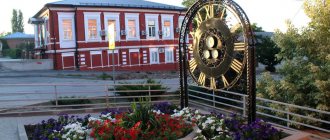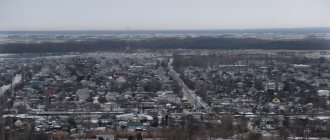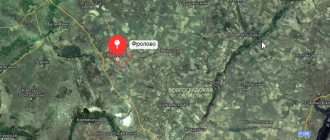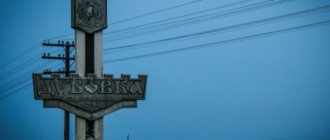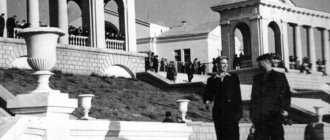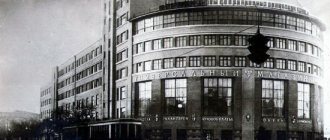Kamyshin is known as a city rich in watermelons. It is here that the Watermelon Festival is held annually in early September, bringing together more than five thousand people in a procession along the central streets to Komsomolskaya Square. Guests from other regions come to participate in the festival. They are interested not only in the carnival procession, but also in competitions - “Obzhorka”, “Watermelon Mochilovo”, “Harvest” and others. Kamyshin is also famous for the fact that it was here that the Hero of the Soviet Union, the famous pilot Alexei Petrovich Maresyev, was born and raised. A monument was erected in his honor, near which a citywide rally is held on May 25 of each year.
History and modernity of the city of Kamyshin, Volgograd region. Interesting facts and more.
Kamyshin is the administrative center.
It is the third largest city in the region. It covers an area of 117 sq. km. The city is divided into two parts (old and new) by a small river. Kamyshinka, which flows into the Volga. Kamyshin is quite intensively built up in the center; on the outskirts, buildings become somewhat rarer. On the outskirts there are garage cooperatives and holiday villages. The development is represented by buildings dating back to different periods of time - there are many ancient buildings here, most of the houses in the city are 5 and 9 floors. The main city streets are, for the most part, wide, straight and paved. Within the city limits there are also private buildings, as well as industrial enterprises, the bulk of which are located in the industrial zone outside the city.
The most famous of them are: a plant for the production of cotton products, a glass container plant, a food plant, the Rotor plant, the Kamyshinsky bread plant and others.
Districts and real estate of Kamyshin
The city is divided by the Kamyshinka River into two parts, which are usually called the “old city” and the “new city”.
Kamyshin Map
You can drive into the “old city” along the Saratov-Volgograd federal highway and, passing the city pine nursery, specially planted more than 100 years ago to protect the city from sand and steppe winds, end up at the bus station. This is an important transport hub of the city; buses run not only within the district or to the nearest large cities (Volgograd, Saratov), but also long-distance passenger flights - for example, to Moscow.
Bus station
The bus station is located on the street. Volgogradskaya. If you drive a little along this street, you can reach Proletarskaya. In this historical center there are ancient merchant buildings built in the 19th century and quite modern 5-9 storey buildings.
Proletarskaya street
Along Proletarskaya Street there are large shops, restaurants and cafes. Apartments in this area are quite expensive compared to citywide prices (a 1-room apartment can cost approximately 900 thousand rubles, a 3-room apartment in the central market area - 1,850 thousand rubles).
Here is also the central city market, medical and music schools, a stadium and a sports school, the central city library and the Druzhba House of Children's Culture, and at some distance a city park.
If you turn from Proletarskaya Street in the Central Market area towards Bazarova Street, you can come to a modern area built up with 9-story buildings, which is called the “3rd town”. Here on the street. Bazarova, real estate prices are lower: 2 rooms. sq. can cost 800 thousand rubles, 3-room apartment. — 1,800 thousand rubles. Note that the 3rd microdistrict and the 3rd town are different areas. The 3rd microdistrict is located in the “New City”, near the street. Nekrasova.
Proletarskaya Street ends at the Borodinsky Bridge over Kamyshinka, from here there is a picturesque panorama of the city embankment, Victory Park (there is an open-air aviation museum), city beaches, and the architectural pearl of the city - the house of Count Olsufiev (now the Museum of Local Lore).
Embankment
If you cross the bridge over Kamyshinka, you can find yourself on Komsomolskaya Square near the railway station. This is another important transport hub of the city.
Railway station
Behind the station and Komsomolskaya Square, already in the “new city”, Proletarskaya Street continues with st. Nekrasova. Modern multi-storey buildings rise here (they are called “Czech” - during the times of Soviet friendship with the sister city Opava, such buildings were built by Czechoslovak builders). Apartments in “Czech” houses are among the most comfortable and expensive for the city (for example, a 2-room apartment can cost 1,800 thousand rubles, a 3-room apartment - 3,800 thousand rubles).
Nekrasova Street
Nekrasova Street connects with Lenin Street. On this, one of the highest points of the city, a monument was built to the famous native of Kamyshin, hero pilot Alexei Maresyev.
Monument to Maresyev
There are other places of memorial glory in the city - the Alley of Heroes, Victory Park.
Lenin Street - .
Lenin Street
One of the most important buildings here is the Tekstilshchik House of Culture, the center of city cultural life. In front of the House of Culture there is a picturesque color and musical fountain. On Lenin Street there are also large shops, a mini-market, and the Pobeda cinema.
Real estate prices are also relatively expensive: 1-sq.m. in the area of the Pobeda cinema it can cost 1200 thousand rubles. Behind the cinema is the area of the cotton mill, the Molodezhny market and then a trip to the holiday villages (Karpunino, Sokolovka).
Palace of Culture
Prices for private houses in Kamyshin are very different: half a house can be bought for 500,000 rubles, while the price for elite cottages can reach 8,000 and even 15,000 thousand rubles. It is also worth taking into account the fact that the entire city is relatively small in size, and you can walk through it in about an hour and a half.
If you don’t turn onto Lenin Street from Nekrasova Street, but drive straight, you can end up in the area of the Glass Container Plant - one of the largest enterprises in the city. The 4th microdistrict is located there, consisting of 5-, 9- and 12-story buildings. Prices in this area are slightly lower than in the center: 2-room. an apartment can cost 1,650 thousand rubles. There is a glass museum at the Glass Container Factory. Here are items of local glassblowers that have artistic value:
One of the remote areas of the city is called the “Industrial Zone”. There are a number of industrial enterprises located there (plant of metalworking tools and others), there is a hotel and a cafe.
Location
On the right bank of the river. Volga, in the very center of the region is the city of Kamyshin. Its name apparently comes from the river. Kamyshinka, at the mouth of which is its location. After the hydroelectric dam was built in the city of Volzhsky, the Volga overflowed in these places so widely that it could reach 9 km in width, creating the impression of an almost endless expanse of water.
The city has a Privolzhskaya railway station and a river port. Trains to the capital and commuter trains depart from the station. In addition, the Syzran-Volgograd federal highway passes here. From the regional center Kamyshin is located 200 km to the north. From here to Saratov it is 180 km in a northerly direction.
Enterprises and work in Kamyshin
There are about 1,400 different enterprises in the city, including 20 large ones.
Among them is a giant cotton mill (in Soviet times it was the largest in Europe, but during perestroika it began to experience difficulties with raw materials supplied from Uzbekistan). Among the enterprises are factories for plumbing and assembly tools, a crane factory, a glass container factory, a canning factory, a silicate factory and others. The food industry is developed (dairy, bakery, brewery and other enterprises).
According to statistics, unemployment is quite high; in Kamyshin it is the third highest in the region. At the same time, the city has a lot of various private enterprises, especially in the service sector (for example, there are about 80 eateries in the city, about 20 hairdressing salons and beauty centers, etc.). The merchant traditions of the last century (today expressed in the supply of various goods) continue to remain relevant. Dacha and melon farming is also widely developed. Therefore, the standard of living as a whole and the general situation make a quite favorable impression.
KhBK
Population
By 2014, the population of Kamyshin exceeded 115 thousand people, and it is constantly growing. And the reason for this is the favorable environment and good climate, which is why people move here from the northern regions. The population is represented by different nationalities - Russians, Ukrainians, Azerbaijanis, Tatars. In Catherine's times, German colonies were located here.
There are Orthodox churches in Kamyshin. The largest and oldest of them is Nikolsky. The historic building houses Trinity Parish. The parish named after the patron saint of the city, Dmitry of Thessaloniki, was restored (the name Kamyshin received the name only under Catherine, and until then it was called Dmitrievsk). The city has a German cultural center and an Armenian community. Interest clubs are open in the local history museum and at libraries.
City infrastructure
The housing stock of Kamyshin is dominated by modern 5- and 9-story new buildings, and in the historical part there are two-story cottage houses preserved from the merchant times of the 19th and early 20th centuries. Not only new buildings are appearing, but also modern, spectacular cottages. Real estate prices are very moderate, and rental prices are also low (on average 4,000-5,000 rubles per month) - however, it is better to clarify the details in each specific case.
The educational sphere of the city is developed quite widely: in the city there are 17 secondary schools, 3 music schools, the House of Children's Creativity, the House of Culture "Textilshchik" and other institutions of children's education. The sports base is well developed - the city has 4 sports schools, 4 swimming pools, the Tekstilshchik stadium and other sports institutions. A sailing regatta is held in August. Among the institutions of secondary education, one can distinguish music and medical schools; there are also several universities.
There are 24 bus routes in the city, minibus taxis operate, and several companies also provide regular taxi services. Passenger transportation can be ordered on suburban and even long-distance intercity flights.
In the city and on the highway, the quality of roads is maintained at a decent level, but this cannot always be said about suburban and country roads: certain suburban sections of the road in the Kamyshinsky district are called “washboard”.
Story
In these regions there are traces of the Pechenegs and Cumans, warriors of the Golden Horde and subjects of the Turkish Sultan Selim II. They are confirmed by discovered mounds, spear tips, jewelry and coins lost in the sand, and even stone Polovtsian idols.
History says that there were few quiet times in these parts. Whoever made raids on these lands - Kuban and Crimean Tatars, Nogais, “thieves' Cossacks” came from the Don. In 1580, an army led by Ermak came here. They dragged themselves across to Kamyshinka from Ilovlya. The same path was taken in 1667 by S. Razin, who was marching with a thousand troops to the Volga.
The first settlement was formed here in the form of a fortress, built in 1668 by order of Tsar Alexei Mikhailovich to protect the Volga trade route and hold back the onslaught of the Don Cossacks, who were making their way along Kamyshinka to the Volga. Two years later, the fortress was burned by the troops of S. Razin, but then it was restored and fortified with a guard garrison.
In 1692, Peter I sent a streltsy regiment to the mouth of Kamyshinka to build a city on the left bank of this small river, which was given the name Dmitrievsk, in honor of the Dmitrievsky streltsy regiment, which arrived from Kazan and was stationed here. The townspeople and serfs of the garrison were the first city residents. Tsar Peter stopped in Dmitrievsk in 1722 on his way to the Persian campaign.
After the discovery of the large Elton salt deposit in 1747, economic growth began in Dmitrievsk. The social composition of the population began to undergo changes. As work progressed on the development and removal of salt from Lake Elton, Ukrainians, called Chumaks, began to arrive in these regions.
In 1774, the city was plundered and partially burned at the hands of Emelyan Pugachev’s subordinates. In 1780, Tsarina Catherine II signed a decree renaming Dmitrievsk to Kamyshin and introducing it into the Saratov province.
In 1781, Kamyshin received the status of a district center, which it proudly wore for another century and a half. There were a lot of merchants here; in terms of merchants, Kamyshin surpassed large cities, for example, Saratov. There were several marinas on the Volga bank, from here grain was sent to the riding cities. Here they also sold fruits, vegetables and the famous Kamyshin watermelons.
The population grew sharply in the 19th century - if in 1825 there were only 2,131 residents of the city, then by 1857 there were 11,165 people.
At the end of the 19th century, a railway section was built in Kamyshin, connecting Tambov and Kamyshin, a wooden bridge across Kamyshinka, a water supply system, steam mills, an oil warehouse, a water tower and four sawmills.
In 1900, the expanding city had a sawmill, a towing ferry, meat and fish shops, 10 slaughterhouses and 12 forges, and the Alexander Park was laid out - considered the best in the Volga region in terms of architectural design at that time. Kamyshin was an important transit point - large flows of cargo passed through it along the Volga.
In 1905, a rally and demonstration took place in the city to reduce taxes and improve working conditions for workers. In 1918, the First Congress of Soviets of Peasant Deputies was held.
In 1920, the first kindergarten, five libraries and a workers' university opened. But after the Civil War, a terrible famine occurred in these places in 1921.
In 1928, a local history museum opened. Much attention was paid to medicine and education - educational and health care institutions and schools for teaching adults to read and write were opened. Various industries were developing.
In the 30s, several enterprises appeared and began to operate successfully: the first bakery, a glass container factory, a plant for the production of varnishes and paints, as well as an enterprise that produced canned meat and vegetable products.
During World War II, enterprises were re-equipped to produce military products, and over 20 thousand Kamyns went to the front. About 7 thousand of them paid with their lives for the victory over the Nazis.
In the 50-60s, large-scale construction of residential apartment buildings and infrastructure took place in the city. The construction, textile, food and other industries were developing, cinemas, cultural centers, children's educational and other institutions, hospitals and clinics were opening.
Weather
The Kamyshin climate is moderate, with cold winters - up to minus 20 degrees and strong winds, and hot summers - in July the weather can be very hot - up to 42 degrees in the shade.
In the warm season, gardens bloom near reservoirs, and summer cottages produce large harvests. In summer and autumn, natural products - fruits, vegetables, berries, honey, etc. can be bought here at symbolic prices. But in areas far from moisture, there are steppes covered with wormwood and similar drought-resistant plants.
The ecology here is very favorable, since large enterprises are located outside the city limits, and there are springs inside it. Fishing is especially popular among the Kamysh people - especially since there are plenty of reservoirs for this - the Volga, Ilovlya, and regional ponds.
Job
Since Kamyshin is one of the most developed regional centers of the Volgograd region, there are a lot of job offers here. And they are located in a variety of areas - food, transport, construction and many others.
For example, a photo salon requires an employee with knowledge of Photoshop and other graphic editors.
Responsibilities include: working with documents - printing, scanning, copier, taking and printing photos, performing image processing and photomontage, accepting orders for souvenirs, selling photo products. Fixed salary + percentage of sales, flexible schedule.
Coat of arms
Kamyshin's coat of arms is presented in the form of a French shield. Three stalks of reeds are depicted in a silver field. They, touching their leaves, grow from the azure tip. The shield is topped with a golden tower crown with three visible teeth. It is complemented by a smooth hoop with embossed ornamental sides and symbolizes the city status and indicates the municipal affiliation of the coat of arms.
The artistic composition was adopted by decision of the Kamyshin City Duma No. 61 of August 27, 2003 (as amended on March 31, 2005).
